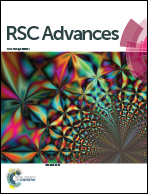Asymmetric binuclear Ni(ii) and Cu(ii) Schiff base metallopolymers†
Abstract
New asymmetric Cu(II)/Cu(II) and Ni(II)/Ni(II) binuclear Schiff base complexes were synthesised via a one-pot reaction introducing two different aldehyde building blocks (R = H, t-Bu). These complexes were successfully electropolymerised to afford new metallopolymers using different sweep scan rates (50, 100 and 200 mV s−1) between 0 and 1.4 V. Surface coverage – (Γ) values were determined assuming ligand-based conduction and are of about 10−7 mol cm−2 for both polymers. Atomic force microscopy (AFM) images showed morphological differences between Cu(II) and Ni(II) polymers with root mean square roughness (Rq) higher for the former. DFT studies support the ligand based electropolymerisation mechanism, based on the electron density of the cation at the para position of the phenolate ring, and suggest that copper dimers prefer slipped square planar geometry, with one Cu–O weak bond between adjacent units, rather than stack as in Ni(II) dimers, in agreement with the AFM observations.


 Please wait while we load your content...
Please wait while we load your content...